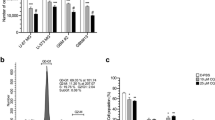Abstract
Human malignant gliomas are commonly resistant to chemotherapy. Here, we examined the role of the multidrug resistance (mdr) mechanism in the chemoresistance of these tumors, using a twofold approach: (i) by assessing a possible mdr phenotype before and after chronic drug exposure of glioma cells in vitro, and (ii) by assessing the modulation of expression of the mdr-associated P-glycoprotein (Pgp) using radiotherapy and serial cycles of chemotherapy in human glioblastoma patients in vivo. T98G, and to a lesser degree, LN-229 human malignant glioma cells exhibit a constitutive mdr phenotype as determined by the modulation of dye transport and by the augmentation of chemosensitivity by the mdr antagonist, verapamil. Thus, coexposure to verapamil enhances the cytotoxicity of vincristine, doxorubicin and VM26 in T98G cells and that of vincristine in LN-229 cells. Chronic exposure of the cells to low concentrations of vincristine and doxorubicin, but not VM26, topotecan or BCNU, moderately enhances the mdr-like phenotype, as assessed by drug expulsion assays. However, chronic exposure to increasing drug concentrations does not significantly alter the sensitivity to the respective drugs. These data are consistent with a constitutive, but not drug-inducible, mdr-like drug resistance in glioma cells in vitro. Immunocytochemical analysis of human malignant gliomas in vivo reveals that Pgp expression is more abundant in endothelial cells within the gliomas, than in the glioma cells proper. Importantly, Pgp expression is unaltered by radiochemotherapy, assessed by comparative immunocytochemistry of glioma specimens obtained serially before and after radiochemotherapy. We conclude that (i) glioma cells exhibit constitutive mdr-like drug resistance that is not significantly altered by chronic drug exposure in vitro; (ii) endothelial cells may play an important role in Pgp-mediated drug resistance of gliomas in vivo; (iii) radiotherapy and repeated chemotherapy cycles do not modulate Pgp expression in human malignant gliomas in vivo; (iv) there is preliminary evidence for a non-Pgp, verapamil-sensitive drug transport activity in glioma cells.
Similar content being viewed by others
Author information
Authors and Affiliations
Additional information
Received: 17 May 1999 / Revised, accepted: 16 August 1999
Rights and permissions
About this article
Cite this article
Rieger, L., Rieger, J., Winter, S. et al. Evidence for a constitutive, verapamil-sensitive, non-P-glycoprotein multidrug resistance phenotype in malignant glioma that is unaltered by radiochemotherapy in vivo. Acta Neuropathol 99, 555–562 (2000). https://doi.org/10.1007/s004010051160
Issue Date:
DOI: https://doi.org/10.1007/s004010051160




